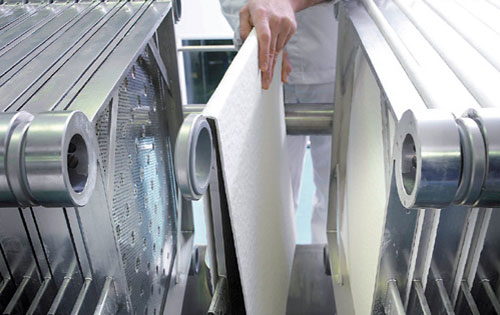This article provides an in-depth guide to plate and frame filters, including their working principle, types, advantages, and applications. It also discusses the benefits of using a plate and frame filter and how it can improve the efficiency and effectiveness of various industries.
Plate and Frame Filter
A plate and frame filter is a type of filter that uses a combination of plates and frames to separate solid particles from liquid or gas. The filter consists of a series of plates and frames that are stacked together, with each plate and frame having a specific function in the filtration process.
The plates are designed to capture larger particles, while the frames are designed to capture smaller particles.

Working Principle of Plate and Frame Filter
The working principle of a plate and frame filter is based on the concept of depth filtration. The liquid or gas to be filtered flows through the filter, and the particles are captured by the plates and frames.
The particles are then collected on the surface of the plates and frames, and the clean liquid or gas flows out of the filter. The plates and frames are designed to provide a large surface area for filtration, which allows for efficient and effective separation of particles.
Types of Plate and Frame Filters
There are several types of plate and frame filters available, including:
- Standard plate and frame filter: This is the most common type of plate and frame filter, which consists of a series of plates and frames that are stacked together.
- High-flow plate and frame filter: This type of filter is designed for applications that require high flow rates, and it consists of a larger number of plates and frames.
- Sanitary plate and frame filter: This type of filter is designed for applications in the food and beverage industry, and it is made of sanitary materials that are easy to clean and maintain.
Advantages of Plate and Frame Filter
The plate and frame filter offers several advantages over other types of filters, including:
- High efficiency: The plate and frame filter can remove a large number of particles from a liquid or gas, making it an efficient choice for a wide range of applications.
- Low cost: The plate and frame filter is a cost-effective option compared to other types of filters, making it an attractive choice for many industries.
- Easy maintenance: The plate and frame filter is easy to maintain and clean, which makes it a reliable choice for applications that require frequent cleaning.

Applications of Plate and Frame Filter
The plate and frame filter has a wide range of applications in various industries, including:
- Chemical processing: The plate and frame filter is used to remove impurities from chemicals, such as sulfur, carbon, and other contaminants.
- Food and beverage processing: The filter is used to remove impurities from food and beverages, such as yeast, bacteria, and other contaminants.
- Pharmaceutical processing: The plate and frame filter is used to remove impurities from pharmaceuticals, such as bacteria, viruses, and other contaminants.
Conclusion:
In conclusion, the plate and frame filter is a versatile and efficient filter that offers a wide range of benefits for various industries. Its high efficiency, low cost, and easy maintenance make it an attractive choice for applications that require frequent cleaning.
By understanding the working principle, types, advantages, and applications of the plate and frame filter, industries can improve their filtration processes and produce high-quality products that meet the demands of their customers.